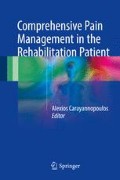Abstract
Neurolysis is an underutilized technique of providing prolonged, and at times permanent, interruption of select neural pathways involved in nociception in cases of chronic, intractable pain. While malignancy-related pain is the most notable and recognizable indication for neurolytic block, any chronic, intractable pain condition that is resistant to more conservative analgesic approaches can be considered to be an indication for neurolysis. This is provided that the pain has a clearly defined etiology and can be reliably assessed using local anesthetic diagnostic blocks prior to proceeding to this irreversible modality. Neural interruption can be undertaken using physical, chemical, and thermal methodologies. The focus of this chapter is to describe techniques of using chemical agents as neurolytics for select indications of moderate-to-severe pain of the head and face, the thorax and abdomen, and of the spine and extremities in the rehabilitation patient.
References
Candido K, Stevens R. Intrathecal neurolytic blocks for treatment of cancer pain. In: Van Aken H, Spinal anaesthesia. Baillère’s best practice & research. Clinical anaesthesiology. Baillère Tindall: London. Vol 17 #3, 2003, p. 407–428.
Suvansa S. Treatment of tetanus by intrathecal injection of carbolic acid. Lancet. 1931;1:1075–8.
Dogliotti AM. Traitement des syndromes doloreaux de la peripherie par l’alcoholisation subarachnoidienne des racines posterieures a leur émergence de la moelle epineri. Presse Med. 1931;39:1249.
Maher RM. Relief of pain in incurable cancer. Lancet. 1955;1:18.
Maher RM. Neurone selection in relief of pain: further experiences with intrathecal injections. Lancet. 1957;1:16.
Candido KD, Knezevic NN. Neurolytic blocks. In: Diwan S, Staatś P, editors. Atlas of pain medicine procedures. New York: McGraw Hill; 2015. p. 666–85.
Labat G. The induction of splanchnic analgesia. Ann Surg. 1924;80(2):161–86.
Candido K, Germanovich A, Ghaly R, Gorelick G. Knezevich: CT-scan guided Gasserian ganglion injection of dexamethasone and lidocaine for the treatment of recalcitrant pain associated with herpes simplex-1 of the ophthalmic division of the trigeminal nerve. Anesth Analg. 2011;112:224–7.
Arcidiacono P, Calori G, Carrara S, McNicol E, Testoni P. Celiac plexus block for pancreatic cancer pain in adults. Cochrane Database of Syst Rev 2011 3; CD007519. Doi:10.1002/14651858
Erdek M, Halpert B, González Fernández M, Cohen S. Assessment of celiac plexus block and neurolysis outcomes and technique in the management of refractory visceral cancer pain. Pain Med. 2010;11:92–100.
Liu S, Fu W, Liu Z, Liu M, Ren R, Zhai H, Li C. MRI-guided celiac neurolysis for pancreatic cancer pain: efficacy and safety. J Magn Reson Imaging. 2016;44(4) doi:10.1002/jmri.25246. [Epub ahead of print]
Wyse J, Carone M, Paquin S, Usatii M, Sahai A. Randomized, double-blind, controlled trial of early endoscopic ultrasound-guided celiac plexus neurolysis to prevent pain progression in patients with newly diagnosed, painful, inoperable pancreatic cancer. J Clin Oncol. 2011;29:3541–6.
Candido K, Philip C, Ghaly R, Knezevic N. Transforaminal 5% phenol neurolysis for the treatment of intractable cancer pain. Anesth Analg. 2010;110:216–9.
Recommended Reading
Adams M, Benzon H, Hurley R. Chemical Neurolytic Blocks. In: Benzon H, Rathmell J, Wu C, Turk D, Argoff C, Hurley R, editors. Practical management of pain, 5th ed. Philadelphia: Elsevier; 2014. p. 784–93.
Lawrence M, Hayek S, Goldner J. Celiac plexus, splanchnic nerve block, and neurolysis. In: Deer TR, editor. Comprehensive treatment of chronic pain by medical, interventional, and integrative approaches. The American academy of pain medicine textbook on pain management. New York: Springer; 2013. p. 427–34.
Waldman S. Ultrasound-guided ganglion of Walther (impar) block. In: Waldman S, editor. Comprehensive atlas of ultrasound-guided pain management injection techniques. Philadelphia: Wolters Kluwer; 2014. p. 857–64.
Wong G, Carns P. Neurolytic celiac plexus block. In: de Leon-Casasola, O, editor. Cancer pain: pharmacological, interventional and palliative care approaches. Philadelphia: Saunders-Elsevier; 2006. p. 409–16.
Author information
Authors and Affiliations
Corresponding author
Editor information
Editors and Affiliations
Rights and permissions
Copyright information
© 2017 Springer International Publishing Switzerland
About this chapter
Cite this chapter
D. Candido, K., England, B. (2017). Neurolytic Injections for the Treatment of Pain in the Rehabilitation Patient. In: Carayannopoulos DO, MPH, A. (eds) Comprehensive Pain Management in the Rehabilitation Patient. Springer, Cham. https://doi.org/10.1007/978-3-319-16784-8_39
Download citation
DOI: https://doi.org/10.1007/978-3-319-16784-8_39
Published:
Publisher Name: Springer, Cham
Print ISBN: 978-3-319-16783-1
Online ISBN: 978-3-319-16784-8
eBook Packages: MedicineMedicine (R0)

